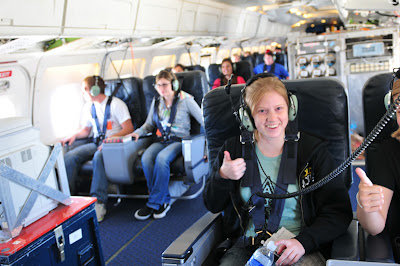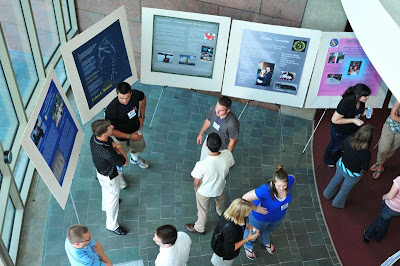By Shawn Kefauver, SARP mentor
Right after the engineering test flight, the Land Team took off for Lost Hills, CA for their field campaign so that they could be ready to go on the ground during the first science overflight. On the menu was collecting field calibration data for their imagery and also all the extra auxiliary data sets necessary for calculating evapotranspiration of almond and pistachio orchards. We started off heading directly to our research field house in Kern County just off of I-5 at the Belridge site of Paramount Farms, our partner farm which supplies the field house and a number of almond and pistachio orchards for experiments.
The land group in the field!
First Dr. Mike Whiting, an assistant research scientist from the CSTARS (Center for Spatial Technologies and Remote Sensing) lab at UC Davis gave a brief introduction of the field crews and study areas of the project. I then led a short tour of the orchards outside and gave a brief demo on the field protocols for measuring leaf area index using hemispherical lens photography.
Then we checked into our hotel and enjoyed a nice sit down dinner at the local Mexican grocery and restaurant. At 6:30 am the next morning, Dr. Susan Ustin met with the team for breakfast and we began our field day right with a good meal. To start the day, we needed to clean off our 30 sq meters of field calibration tarps from the dusty winds the night before.
Cleaning the field calibration tarps
At 9:30 AM the team split up and half headed out for leaf sampling. The other half helped with the leaf scanning and thermal calibration data collection at the time of the first overflight.
Watching the DC-8 fly overhead
At solar noon I headed with my VNIR (Visible and Near Infrared) calibration team to collect spectral reflectance data for empirical line and BRDF (Bidirectional reflectance distribution function) corrections using our portable full range spectroradiometer.
SARPians use the portable spectroradiometer
In the afternoon the teams switched and in the evening we had a few field data processing demos. We all went out to take some air samples for the Air Team, and then the LAI (Leaf Area Index) specialization team headed out for an extra hour of hemispherical lens photography to help the CSTARS team catch up on some sunset data collection. By then we were all ready to go to sleep early after a long day to rest up for an early 4:30 AM departure the next day in order to make the SARP tour of the Dryden Flight Research Center.




































